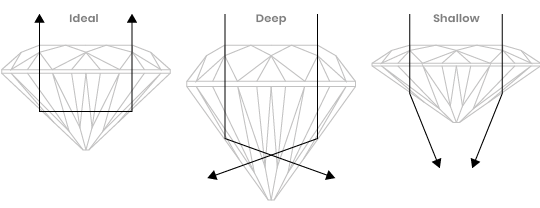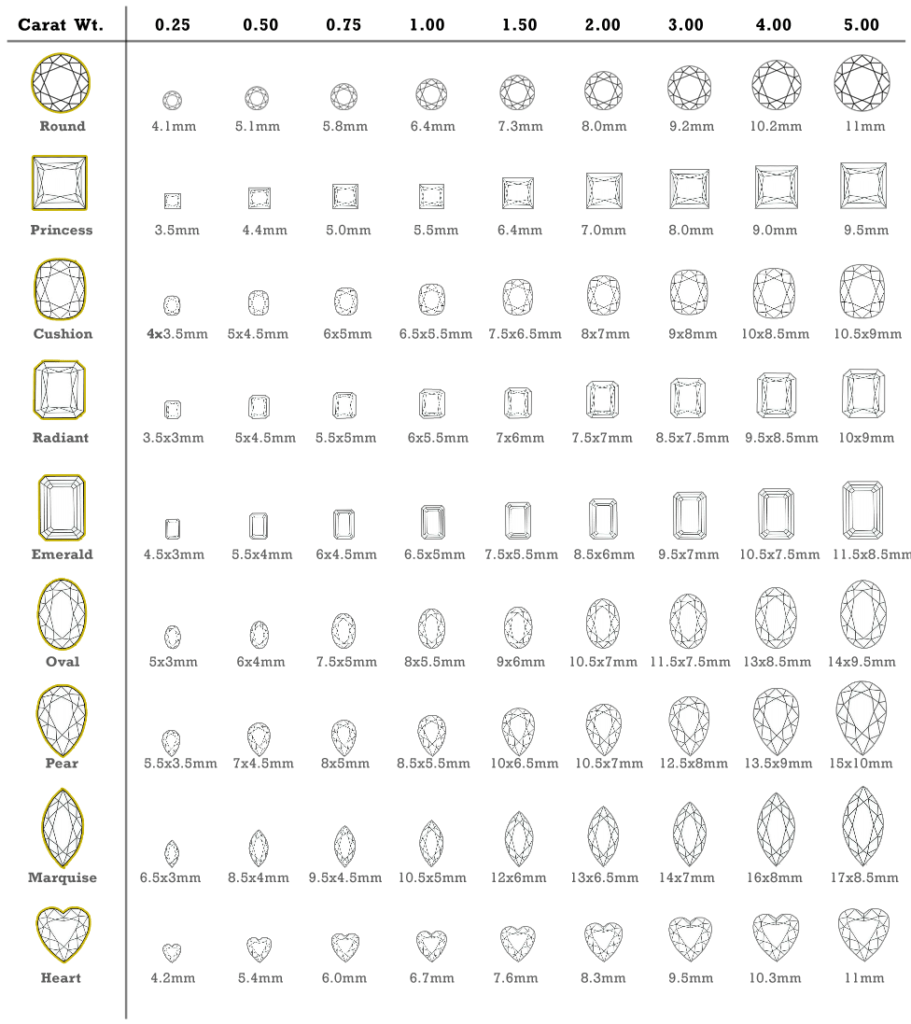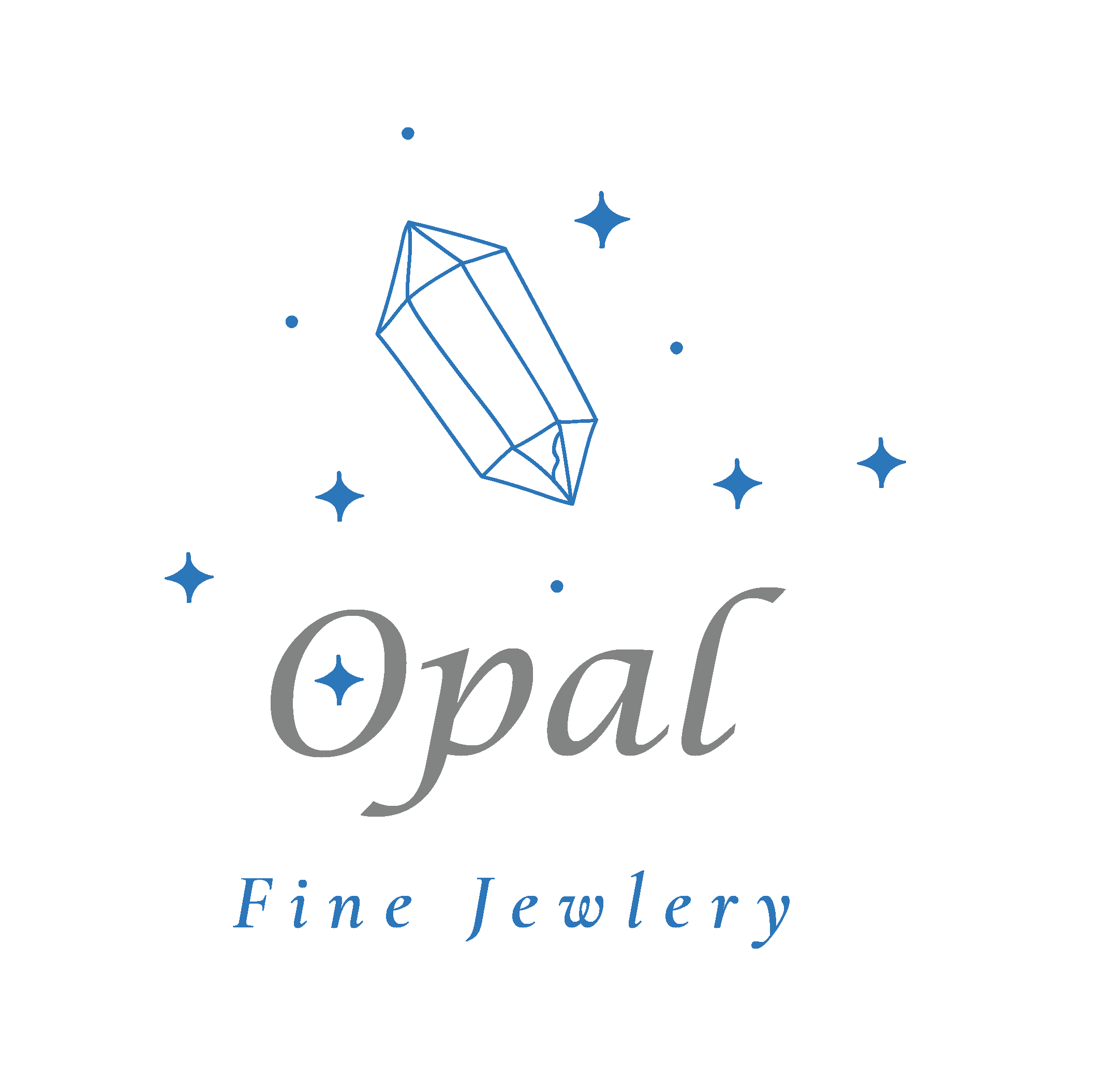4Cs of Diamond Quality by Sophy Geneva
The very word “diamond” comes from the Greek “adamas” meaning unconquerable and suggesting the eternity of love. Ancient Greeks believed that diamonds were splinters of stars fallen to earth. While Romans thought that Cupid’s arrows were tipped with diamonds which had a magic that nothing else could ever quite equal.
Diamonds are very simple in composition, they are pure carbon (C) which has remarkable optical characteristics. They were originated 3.3 billion years ago. Diamonds are created when carbon is put under immense pressure and temperature deep within the earth.
Diamonds, being so precious and valuable, needed a universal grading system that was developed by The Gemological Institute of America (GIA) during the 1940s and 1950s, in order to fairly compare and evaluate diamonds. Nowadays, it is known as the “GIA International Diamond Grading SystemTM” or commonly known as the “4Cs.”


Clarity:
How clean the diamond is of inclusions and blemishes.
A Diamond’s Clarity grade evaluates how clean a diamond is from both inclusions and blemishes. Clarity is graded by the GIA on the following diamond clarity chart:
- FL (Flawless)
- IF (Internally Flawless)
- VVS1 (Very, Very Slightly Included 1)
- VVS2 (Very, Very Slightly Included 2)
- VS1 (Very Slightly Included 1)
- VS2 (Very Slightly Included 2)
- SI1 (Slightly Included 1)
- SI2 (Slightly Included 2)
- I1 (Inclusions 1)
- I2 (Inclusions 2)
Note that each diamond differs slightly. Rather than sticking to a particular grade on the diamond clarity chart, review each diamond to see if you notice imperfections.
Diamond clarity chart: This diamond clarity grading scale shows and sums up each clarity grade. Check the chart below.
As you work your way across the diamond clarity chart, you’ll notice how more inclusions and blemishes are visible. Not all imperfections are visible to the naked eye, though. That’s why it’s important to look at each individual diamond.


Cut
A Diamond’s Cut Unleashes Its Light
Diamonds are renowned for their ability to transmit light and sparkle so intensely. We often think of a diamond’s cut as a shape (round, heart, oval, marquise, pear), but a diamond’s cut grade is really about how well a diamond’s facets interact with light. Precise artistry and workmanship are required to fashion a stone so its proportions, symmetry, and polish deliver the magnificent return of light only possible in a diamond.
A diamond’s cut is crucial to the stone’s final beauty and value. And of all the diamond 4Cs, it is the most complex and technically difficult to analyze
To determine the cut grade of the standard round brilliant diamond – the shape that dominates the majority of diamond jewelry – GIA calculates the proportions of those facets that influence the diamond’s face-up appearance. These proportions allow GIA to evaluate how successfully a diamond interacts with light to create desirable visual effects such as:
- Brightness: Internal and external white light reflected from a diamond
- Fire: The scattering of white light into all the colors of the rainbow
- Scintillation: The amount of sparkle a diamond produces, and the pattern of light and dark areas caused by reflections within the diamond.


Color
Ironically, when speaking of grading a diamond for its color the meaning is actually the diamond’s lack of color (unless speaking on fancy colored diamonds). Colors are graded on a scale of D – Z (alphabetical) *please check the chart below. D being the purest and most lucid color, completely colorless. As you go down the alphabet the diamond gets a slight tone of color, yellow or brown.
D – Colorless
E-F – Colorless
G-J – Near Colorless
K-M – Faint Yellow
N-R – Very Light Yellow
S-Z – Light Yellow
After ‘Z’ on the color scale, diamonds become fancy yellow, which cost more because of their rarity.


Carat
The word carat derives from the word carob, a Mediterranean seed, which has an extremely consistent weight for measuring. The greater the carat weight, the rarer, and more valuable the diamond becomes. Five metric carats weighs exactly 1 gram.
The larger the stone, the rarer and more valuable it is although the size of the stone is not the only indication of its value. For example: a large stone can have a smaller value due to its poor cut, clarity and color. Every stone is unique therefore it is important to consider the combination of those factors when choosing a diamond.
Larger diamonds are discovered less often than smaller ones. Ergo, large diamonds are rare and have a greater value per carat. For that reason, the price of a diamond rises exponentially to its size.
“Big girls need big diamonds.” ― Elizabeth Taylor


Diamond Carat Weights estimated sizes by Sophy Geneva

How the 4Cs Work Together
Each of the 4 C’s contribute to the overall beauty of a diamond and make each stone unique. A Diamond, however, should be viewed as an organic whole. Because the eye has difficulty differentiating one diamond characteristic by itself, such as Clarity or Color, it is important to consider how the 4 C’s impact each other.
which is the most important of the four Cs?
- Cut: The most important of all the diamond characteristics as it most readily impacts a diamond’s beauty. Look for high levels of brilliance and fire, and be willing to reduce your spending in other areas like Clarity or Color to ensure an exceptional Cut.
- Color: The second most important aspect to focus on. A diamond should look white or colorless to the naked eye. Ensure the Color does not distract or interfere with white and colored light reflection.
- Clarity: The third most important characteristic on the list. Choose a diamond that is eye clean. Blemishes and inclusions should not distract from the brilliance or fire of a diamond.
- Carat: Last but not least. Consider what is important for you and the one you love, but remember that brilliance and beauty will outshine mere weight each and every time. Be open to lowering your Carat weight to ensure you purchase a stunning diamond.
With these fundamentals in mind, remember that a diamond is a precious whole, and should be looked at in totality. The four main qualities of a diamond all play an important role in how the diamond looks.










